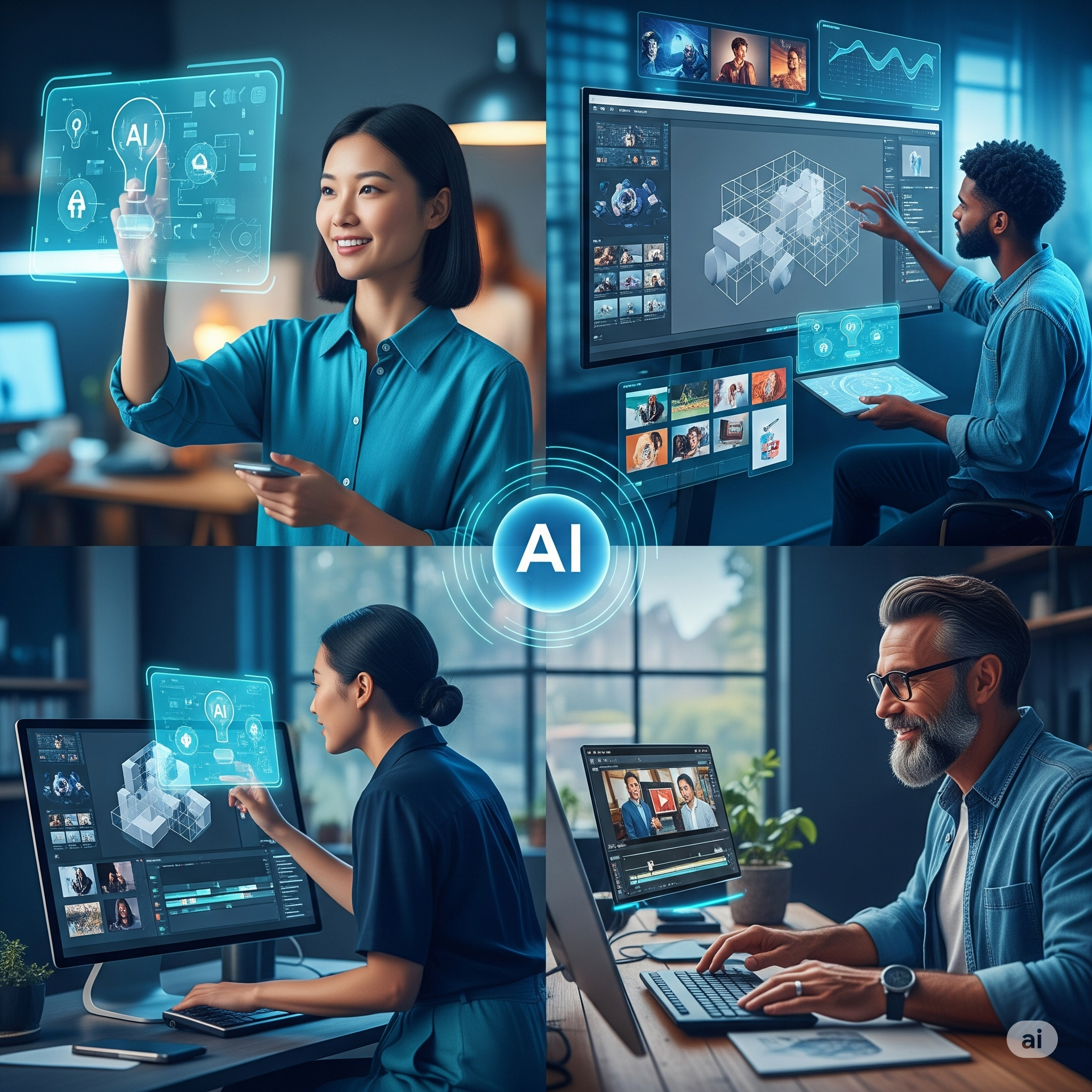In today’s fast-paced world, productivity is the cornerstone of success, both personally and professionally. As we strive to do more with less, the quest for efficiency drives us to explore innovative tools and methodologies. Artificial intelligence (AI) has emerged as a transformative force, offering unprecedented capabilities to automate tasks, streamline workflows, and free up valuable time.
At AiFocusPro, we firmly believe that AI is not just the future, but the present of productivity. This comprehensive guide will show you how AI-powered task automation can revolutionize the way you work, turning tedious routines into strategic opportunities. Get ready to unlock AI’s potential to boost your productivity and propel you to new heights.
Automating Routine Office Tasks: Free Up Your Time for What Matters

Imagine for a moment the time you spend each day on repetitive, uninspiring tasks. Replying to emails, scheduling meetings, managing data… These activities, while necessary, can accumulate and stifle your momentum. AI is here to help you regain control of your schedule.
Intelligent Email and Calendar Management
Overflowing inboxes are a productivity bane. AI can transform your relationship with emails and schedules.
- Automatic email sorting and categorization: Tools like Gmail Smart Reply or third-party platforms like SaneBox use AI to identify important emails, filter spam, and suggest quick replies. This reduces the time spent sifting through messages, allowing you to focus on essential communications. A McKinsey & Company study estimates that workers spend an average of 28% of their work week managing emails, highlighting the enormous potential for time savings through automation.
- Effortless meeting scheduling: No more endless back-and-forth trying to find a time slot. AI-powered scheduling assistants, such as Calendly or Doodle’s AI assistant, can interact with participants, check availability, and block out slots, saving you valuable time. x.ai, for example, can act as a personal assistant to schedule your meetings without any intervention from your side.
Data Entry and Organization: The End of Manual Chores
Manual data entry is not only time-consuming but also prone to human error. AI offers robust solutions to automate this process.
- Automated data extraction: Whether from PDF documents, images, or forms, AI tools with advanced Optical Character Recognition (OCR) can extract relevant information with high accuracy. Software like ABBYY FineReader or cloud services such as Google Cloud Vision AI allow you to scan and make documents searchable, transforming piles of paper into structured data.
- Spreadsheet cleaning and organization: Messy datasets can be a nightmare. AI can identify and correct inconsistencies, remove duplicates, and structure data logically. Built-in features in spreadsheets like Microsoft Excel with “Flash Fill” or more advanced machine learning-powered tools can transform raw data into actionable insights with just a few clicks.
Automating Administrative Workflows: Efficiency at Your Fingertips
From managing invoices to preparing reports, many administrative tasks can be optimized by AI.
- Expense management and invoicing: Platforms like Expensify or Wave Accounting use AI to scan receipts, categorize expenses, and automate the reimbursement process. This significantly reduces the time spent by employees and the finance department.
- Simplified report generation: AI can compile data from various sources and generate customized reports on the fly. AI-powered data analytics tools like Tableau or Power BI (with their natural language capabilities) can create visualizations and summaries from simple queries, transforming complex data analysis into an intuitive process.
AI in Creative and Content Workflows: Amplifying Creativity

AI isn’t just for repetitive tasks; it’s also a powerful catalyst for creativity and content production. Far from replacing human ingenuity, AI acts as a co-pilot, accelerating processes and offering new perspectives.
Writing and Content Generation: Beyond the Blank Page
One of the most promising areas of AI is text generation.
- AI-assisted writing: Tools like Jasper AI (formerly Jarvis) or Copy.ai can generate quality drafts for blog posts, social media captions, product descriptions, or even scripts. They use advanced language models to understand context and produce relevant, engaging text, freeing creators from writer’s block and allowing them to focus on refining the message. According to a report by Grand View Research, the AI content generation market is projected to reach $22.2 billion by 2030, highlighting the growing adoption of these tools.
- Automated SEO optimization: AI can analyze keywords, search trends, and competitor content to suggest SEO optimizations. Platforms like Surfer SEO or Frase.io help writers create content that ranks better in search engines, increasing visibility and impact.
Graphic Design and Visual Creation: Turning Ideas into Images
AI is also revolutionizing the way we create visuals.
- Image and design generation: AI-powered tools like Midjourney, DALL-E 3, or Canva Magic Studio allow you to generate unique images from text descriptions, modify existing photos, or create complex designs with astonishing ease. This opens new avenues for marketers, designers, and artists, reducing the time and costs associated with visual production.
- Brand personalization: AI can analyze user preferences and demographic data to suggest design elements, color palettes, and typographies that resonate best with the target audience, ensuring brand consistency across all platforms.
Video Editing and Audio Production: The Studio at Your Fingertips
Multimedia production, traditionally long and expensive, is becoming more accessible thanks to AI.
- Intelligent video editing: Software like Descript uses AI to transcribe a video’s audio and allows users to edit the video by simply editing the text. This significantly speeds up the editing process. Other tools can automate scene detection, color grading, and even subtitle creation.
- Audio enhancement and generation: AI can remove background noise, improve vocal clarity, or even generate realistic voiceovers from text. Platforms like Adobe Podcast AI offer impressive features to transform raw recordings into professional-quality productions.
Advanced AI Automation for Business Processes: Enterprise-Scale Efficiency

AI’s impact extends far beyond individual tasks, transforming entire business processes for increased efficiency and intelligence. Robotic Process Automation (RPA), combined with AI, is becoming a powerful engine for innovation.
Customer Service and Support: Enhanced Interactions
AI has transformed customer service, making it faster, more personalized, and available 24/7.
- Intelligent chatbots: AI-powered chatbots can handle a high volume of customer queries, answer frequently asked questions, guide users, and even resolve complex issues without human intervention. Companies like Zendesk and Intercom integrate AI capabilities to enhance their customer service solutions. A Salesforce survey revealed that 69% of customers prefer using chatbots for quick queries, highlighting their effectiveness.
- Smart query routing: AI can analyze customer queries and automatically direct them to the most qualified agent, reducing wait times and improving customer satisfaction.
- Sentiment analysis: AI can analyze the tone and content of customer interactions to gauge sentiment and identify potential issues before they escalate.
Supply Chain Management and Logistics: End-to-End Optimization
AI brings unprecedented visibility and efficiency to complex supply chains.
- Demand forecasting: AI algorithms can analyze vast volumes of data (sales history, market trends, weather conditions, etc.) to forecast demand with increased accuracy, helping businesses optimize stock levels and reduce surpluses or shortages. Giants like Amazon use AI to refine their logistics operations.
- Delivery route optimization: AI can calculate the most efficient routes in real-time, taking into account traffic, weather conditions, and delivery constraints, which reduces fuel costs and delivery times.
- Fraud detection and risk management: AI can identify abnormal patterns in transactions or supply chain data, flagging fraudulent activities or potential risks before they cause significant losses.
Finance and Accounting: Precision and Compliance
The finance sector greatly benefits from AI automation, improving accuracy and compliance.
- Automated auditing: AI can review vast financial datasets to identify errors, inconsistencies, or irregularities, making audits faster and more reliable.
- Financial fraud detection: Banks and financial institutions use AI to analyze transaction patterns and identify suspicious activities that may indicate fraud, significantly reducing financial losses. Juniper Research predicts that AI will save financial institutions over $10 billion annually in fraud detection by 2027.
- Automated reporting and compliance: AI can generate detailed financial reports and ensure compliance with regulatory requirements by automatically reviewing data against established rules and flagging any deviations.
Implementing AI Automation: A Human-Centric Approach
While the benefits of AI automation are clear, successful implementation requires a thoughtful, human-centric approach. It’s not about replacing people, but empowering them.
Start Small, Think Big
Don’t try to automate everything at once. Begin with small, manageable tasks that yield quick wins. This builds confidence and demonstrates the value of AI within your organization. Identify repetitive, rule-based tasks that consume a lot of time but require little human judgment.
Focus on Value, Not Just Technology
The goal isn’t just to implement AI; it’s to solve problems and create value. Before automating, ask yourself:
- What pain points can AI address?
- How will this automation improve efficiency, reduce costs, or enhance the customer experience?
- How will it free up my team to focus on higher-value activities?
Upskill Your Workforce
AI automation will change job roles. Instead of viewing it as a threat, see it as an opportunity for growth. Invest in training your employees to work alongside AI, focusing on skills like data analysis, critical thinking, problem-solving, and managing AI tools. The future workforce will be one that collaborates effectively with intelligent systems.
Ethical Considerations and Data Privacy
As with any powerful technology, ethical considerations are paramount. Ensure that your AI implementations are fair, transparent, and respect user privacy. Data security should be a top priority, adhering to regulations like GDPR or CCPA. Always consider the potential biases in data used to train AI and strive for diverse, unbiased datasets.
Embrace the AI Revolution for Unprecedented Productivity
The age of AI-powered task automation is not just a glimpse into the future; it’s here, now, transforming how we work and live. From streamlining routine office tasks to amplifying creativity in content production and revolutionizing complex business processes, AI offers an unparalleled opportunity to boost your productivity.
At AiFocusPro, we believe that embracing AI is not just about adopting new technology; it’s about embracing a new mindset – one that prioritizes efficiency, innovation, and strategic thinking. By automating the mundane, you unlock precious time and resources to focus on what truly matters: creativity, problem-solving, and human connection.
Are you ready to unlock your full potential? Start your journey with AI-powered task automation today. Explore the tools and strategies discussed in this guide, experiment with small implementations, and witness firsthand how AI can transform your daily work. The future of productivity is intelligent, automated, and incredibly empowering. Let AiFocusPro be your guide on this exciting path!